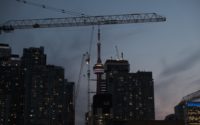Canada's federal government has made one of its biggest infrastructure moves in years, pledging to spend nearly $10 billion to accelerate five transit projects in Ontario as a COVID-19 economic boost, in a long gestating deal among federal, provincial and local officials.
Ottawa plans to pump most of the money, about $8.5 billion, into four Toronto-area projects to cover 40% of their cost, with the remainder to be spent on light rail in the city of Hamilton, 50 miles south, which the province had previously cancelled due to cost hikes.
The total cost of the five projects is about $24.7 billion. Financing negotiations took about six months, according to CBC of Canada.
The announcement is one of the largest federal infrastructure outlays since Prime Minister Justin Trudeau’s Liberal government launched a $14-billion, 12-year infrastructure investment plan in 2016, coming now at a time of new concern about the pace at which federal infrastructure dollars have been converted into actual projects.
“This is a big deal for a number of reasons,” said Matti Siemiatycki, an associate professor of urban planning at the University of Toronto. "It’s a lot of money, and funding has tended to be a hurdle for transit projects in Canada.”
Transit Projects on the Move
The $9-billion Ontario Line would expand rapid transit through downtown Toronto, with as many as 15 stations and 17 connections to other subway and light rail lines. A team led by design firm HDR was hired last year as Ontario line project technical adviser, along with Mott MacDonald, Stantec, Systra and Comtech, to provide planning, engineering, environmental review, design and construction oversight services.
The three other area projects, described as “shovel ready” in a federal infrastructure ministry announcement, are the $4.5-billion Scarborough subway extension; $3.9-billion Eglinton Crosstown West light rail extension; and $4.6-billion Yonge North subway extension to reach three northern suburbs.
“We are making the largest investment in public transit in [Toronto] history—helping to kickstart our economy and create tens of thousands of jobs,” federal infrastructure minister Catherine McKenna said.
Austria-based tunneling contractor Strabag AG leads a design-construction team selected by Infrastructure Ontario in March for the Scarborough project, which also includes Arup Canada Inc. and Brian Isherwood & Associates Ltd.
The Eglinton Crosstown project already is under construction, with the federal money to help fund a western extension along Eglinton Ave., between Scarborough and Mississauga. Transit agency Metrolinx selected, also in March, that project's design and construction team led by Aecon Infrastructure Management Inc.and Dragados Canada Inc., and including design firms TYPSA Inc., EXP Services Inc., Dr. G. Sauer & Partners Corp. and Pedelta Canada Inc.
Both selections now are being finalized, with agencies also set to issue separate contracts for the projects to cover construction of stations, tunnel fit-outs and system installation and commissioning.
The light-rail project in Hamilton still must gain final approval from local officials.
Patrick Dillon, business manager and secretary treasurer of the Provincial Building and Construction Trades Council of Ontario, said the federal funding's impact is “almost immeasurable” in generating multi-billion-dollar economic spinoff from the projects.
Dillon said the projects could create 6,000 to 7,000 new construction jobs over the next few years.
“I think one of the things that doesn’t get talked about here is that it is with those kinds of projects we will build Ontario’s future trades workforce,” he said. “You can’t sustain the economy without training the future workforce.”
The federal government had previously said it would increase its contribution from 30% to 40% on transit projects, but the Ontario funding announcement is one of the first major commitments, Siemiatycki said. It also greatly increases the likelihood the projects will actually get built.
“Now they have real money,” Siemiatycki said, referring to the federal commitment, alongside Ontario’s pledge of $14 billion.
Still, some wild cards remain, mostly tied to local, provincial and national politics.
Trudeau now leads a minority government that could “fall at any time,” Siemiatyck said, and the Progressive Conservative government in Ontario is “deeply unpopular” over its handling of the COVID-19 crisis, with a provincial election in about a year. He noted that “some of this is electioneering.”
Others question the expansions when ridership is down.
But Dillon, the union leader, said he is heartened by cooperation between the federal Liberal Party government and the Progressive Conservatives in Ontario.
“We are very pleased seeing that the federal and provincial governments could set aside the immediate politics to come together on this,” he said.





Post a comment to this article
Report Abusive Comment